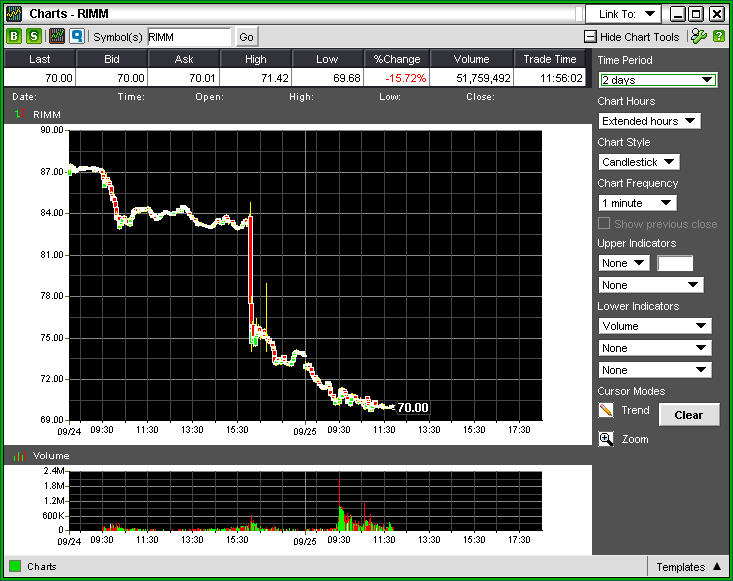RIM signals price war potential; Fallout could be substantial

Research in Motion's second quarter sounded alarm bells and may have signaled a smartphone price war, according to analysts. The company's contention that it would target a 'more mainstream' market was viewed as a sign that average selling prices would fall for multiple vendors.
The scenario for the fourth quarter outlook for smartphone makers is clear: The vendor that is able to hold pricing wins. The problem: Buzz and mindshare may be highly overrated when it comes to maintaining smartphone prices. The good news: What's bad for vendors may be good for you---especially if $99 becomes the new $199 for smartphones.
RIM delivered a dud of a quarter where fiscal second quarter fell short of Wall Street estimates as did the third quarter outlook. As reported, RIM was hammered in afterhours trading and shares are falling further on Friday.
J.P. Morgan analyst Paul Coster highlights the fallout from RIM's quarter:
We believe this presents PALM with an inevitable challenge heading into the holiday season. Notwithstanding the differentiated WebOS, a subset of Palm's target market will be won and lost on price.
The big fear for financial types: The window of strong pricing for smartphones is becoming smaller rapidly. Launch new phone, enjoy the $199 price (with subsidies) for a month or so and then the race to $99 a device begins.
RIM co-CEO James Balsillie said on a conference call that it's necessary to gain share. That means pricing may fall as a result. The big plan: Use the razor blade business model: Cheap devices with value added services. Balsillie said:
This is a -- kind of a land grab and although we didn’t talk a lot about this on the call, we talked before, there’s a great set of value-added services stuff which you are going to see a lot of unveiling, the capabilities, some of them at our developer conference in early November.
So the key for us is ASPs, it’s a mix thing right now but there is some component cost savings. But we are also coming up with higher end devices and you are going to see more of those launched in the quarter as opposed to the 8520, which is a very high performance but lower cost unit and -- but we are also seeing margins preserved, so the long-term trend is more capability per dollar and it’s a question of how much people want to put in versus how much they want in price but there’s some pretty high-end devices we’ve got teed up.
Analysts weren't impressed. Goldman Sachs analyst Simona Jankowski said RIM's quarter was a "thesis-changing quarter." Jankowski downgraded RIM to a neutral from buy. Jankowski says that she doubts RIM can hold market share. Add it up and you have potentially falling prices and declining market share:
We now believe that RIM is unlikely to maintain its 50%-plus share in North America in the face of increasing competition from Apple, Motorola, and Palm, among others. Our previous view, supported by our 9/2/09 Smartphone Survey, was that RIM could grow at least in line with the North America market, despite even faster share gains by Apple, as it had a formidable lead over all other competitors. While RIM lost share for the first time in CQ2, we attributed that to a normalization after its very strong CQ1 (driven by the Storm launch at Verizon) coupled with the iPhone 3GS launch. However, we now believe RIM lost share again in CQ3 despite launching the Javelin at AT&T and the Tour at Verizon and Sprint. Moreover, the competitive environment in CQ3 was relatively benign compared to the expected onslaught of Android-based smartphones over the coming months. As a result, we now think it is unlikely that RIM will maintain its North America share.
Deutsche Bank analyst Brian Modoff also joined the "sell RIM now!" parade. Modoff's beef: 80 percent of RIM's revenue in the third quarter came from consumers. While that fact is helping RIM grow enterprise customers maintain pricing. Modoff highlights the conundrum. He says:
- RIM has a growing reliance on "fickle consumer tastes in cell phones."
- Other than the Storm, RIM hasn't revamped its product line-up.
- The BlackBerry doesn't stand out and RIM will increasingly have to gain share with low prices.
- The problem will get worse because RIM will face competition from Apple and a bevy of others.
Modoff writes:
We see several dozen new smartphones coming on stream in the next six months. This includes solid offerings from Motorola, Palm, HTC, Samsung and LG. Our checks with carriers indicate that they are looking to drive smartphone prices to subsidized levels below $100. RIM may be able to manage its bill of materials down in this environment, but we think price declines will have an impact on gross margins. And this transition will likely be a painful process.
Painful indeed:
